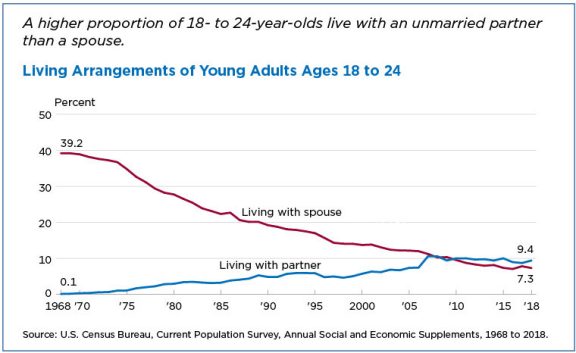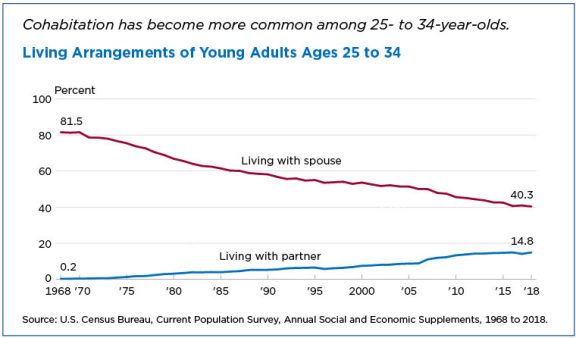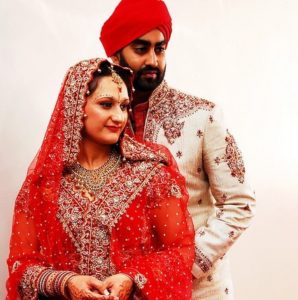8.5: Trends in Dating, Cohabitation, and Marriage
- Last updated
- Save as PDF
- Page ID
- 140895
Learning Outcomes
- Describe trends and norms in dating, cohabitation, and marriage in the United States
Dating
In general, traditional dating among teens and those in their early twenties has been replaced with more varied and flexible ways of getting together (and technology with social media, no doubt, plays a key role). The Friday night date with dinner and a movie that may still be enjoyed by those in their 30s gives way to less formal, more spontaneous meetings that may include several couples or a group of friends. Two people may get to know each other and go somewhere alone. How would you describe a “typical” date? Who calls, texts, or face times? Who pays? Who decides where to go? What is the purpose of the date? In general, greater planning is required for people who have additional family and work responsibilities.
Dating and the Internet
The ways people are finding love has changed with the advent of the Internet. In a poll, 49% of all American adults reported that either themselves or someone they knew had dated a person they met online (Madden & Lenhart, 2006). As Finkel and colleagues (2007) found, social networking sites, and the Internet generally, perform three important tasks. Specifically, sites provide individuals with access to a database of other individuals who are interested in meeting someone. Dating sites generally reduce issues of proximity, as individuals do not have to be close in proximity to meet. Also, they provide a medium in which individuals can communicate with others. Finally, some Internet dating websites advertise special matching strategies, based on factors such as personality, hobbies, and interests, to identify the “perfect match” for people looking for love online. In general, scientific questions about the effectiveness of Internet matching or online dating compared to face-to-face dating remain to be answered.
It is important to note that social networking sites have opened the doors for many to meet people that they might not have ever had the opportunity to meet; unfortunately, it now appears that the social networking sites can be forums for unsuspecting people to be duped. In 2010 a documentary, Catfish, focused on the personal experience of a man who met a woman online and carried on an emotional relationship with this person for months. As he later came to discover, though, the person he thought he was talking and writing with did not exist. As Dr. Aaron Ben-Zeév stated, online relationships leave room for deception; thus, people have to be cautious.
Cohabitation
Cohabitation is an arrangement where two people who are not married live together. They often involve a romantic or sexually intimate relationship on a long-term or permanent basis. Such arrangements have become increasingly common in Western countries during the past few decades, being led by changing social views, especially regarding marriage, gender roles and religion. Today, cohabitation is a common pattern among people in the Western world. In Europe, the Scandinavian countries have been the first to start this leading trend, although many countries have since followed. Mediterranean Europe has traditionally been very conservative, with religion playing a strong role. Until the mid-1990s, cohabitation levels remained low in this region, but have since increased. Cohabitation is common in many countries, with the Scandinavian nations of Iceland, Sweden, and Norway reporting the highest percentages, and more traditional countries like India, China, and Japan reporting low percentages (DeRose, 2011).
In countries where cohabitation is increasingly common, there has been speculation as to whether or not cohabitation is now part of the natural developmental progression of romantic relationships: dating and courtship, then cohabitation, engagement, and finally marriage. Though, while many cohabitating arrangements ultimately lead to marriage, many do not.
How prevalent is cohabitation today in the United States? According to the U.S. Census Bureau (2018), cohabitation has been increasing, while marriage has been decreasing in young adulthood. As seen in the graph below, over the past 50 years, the percentage of 18-24 year olds in the U.S. living with an unmarried partner has gone from 0.1 percent to 9.4 percent, while living with a spouse has gone from 39.2 percent to 7 percent. More 18-24 year olds live with an unmarried partner now than with a married partner.

While the percent living with a spouse is still higher than the percent living with an unmarried partner among 25 to 34-year-olds today, the next graph clearly shows a similar pattern of decline in marriage and increase in cohabitation over the last five decades. The percent living with a spouse in this age group today is only half of what it was in 1968 (40.3 percent vs. 81.5 percent), while the percent living with an unmarried partner rose from 0.2 percent to 14.8 percent in this age group. Another way to look at some of the data is that only 30% of today’s 18 to 34-year-olds in the U.S. are married, compared with almost double that, 59 percent forty years ago (1978). The marriage rates for less-educated young adults (who tend to have lower income) have fallen at faster rates than those of better educated young adults since the 1970s. Past and present economic climate are key factors; perhaps more couples are waiting until they can afford to get married, financially. Gurrentz (2018) does caution that there are limitations of the measures of cohabitation, particularly in the past.[1]

How long do cohabiting relationships last?
Cohabitation tends to last longer in European countries than in the United States. Half of cohabiting relationships in the U. S. end within a year; only 10 percent last more than 5 years. These short-term cohabiting relationships are more characteristics of people in their early 20s. Many of these couples eventually marry. Those who cohabit more than five years tend to be older and more committed to the relationship. Cohabitation may be preferable to marriage for a number of reasons. For partners over 65, cohabitation is preferable to marriage for practical reasons. For many of them, marriage would result in a loss of Social Security benefits and consequently is not an option. Others may believe that their relationship is more satisfying because they are not bound by marriage.
Think it Over
Do you think that you will cohabitate before marriage? Or did you cohabitate? Why or why not? Does your culture play a role in your decision? Does what you learned in this module change your thoughts on this practice?

Same-Sex Couples
As of 2019, same-sex marriage is legal in 28 countries, and counting. Many other countries either recognize same-sex couples for the purpose of immigration, grant rights for domestic partnerships or grant common law marriage status to same-sex couples.
Same-sex couples struggle with concerns such as the division of household tasks, finances, sex, and friendships as do heterosexual couples. One difference between same-sex and heterosexual couples, however, is that same-sex couples have to live with the added stress that comes from social disapproval and discrimination. And continued contact with an ex-partner may be more likely among homosexuals and bisexuals because of the closeness of the circle of friends and acquaintances.
The number of adults who remain single has increased dramatically in the last 30 years. We have more people who never marry, more widows and more divorcees driving up the number of singles. Singles represent about 25 percent of American households. Singlehood has become a more acceptable lifestyle than it was in the past and many singles are very happy with their status. Whether or not a single person is happy depends on the circumstances of their remaining single.
Stein’s Typology of Singles
Many of the research findings about singles reveal that they are not all alike. Happiness with one’s status depends on whether the person is single by choice and whether the situation is permanent. Let’s look at Stein’s (1981) four categories of singles for a better understanding of this.
- Voluntary temporary singles: These are younger people who have never been married and divorced people who are postponing marriage and remarriage. They may be more involved in careers or getting an education or just wanting to have fun without making a commitment to any one person. They are not quite ready for that kind of relationship. These people tend to report being very happy with their single status.
- Voluntary permanent singles: These individuals do not want to marry and aren’t intending to marry. This might include cohabiting couples who don’t want to marry, priests, nuns, or others who are not considering marriage. Again, this group is typically single by choice and understandably more contented with this decision.
- Involuntary temporary: These are people who are actively seeking mates. They hope to marry or remarry and may be involved in going on blind dates, seeking a partner on the internet or placing “getting personal” aids in search of a mate. They tend to be more anxious about being single.
- Involuntary permanent: These are older divorced, widowed, or never-married people who wanted to marry but have not found a mate and are coming to accept singlehood as a probable permanent situation. Some are bitter about not having married while others are more accepting of how their life has developed.
Engagement and Marriage
Most people will marry in their lifetime. In the majority of countries, 80% of men and women have been married by the age of 49 (United Nations, 2013). Despite how common marriage remains, it has undergone some interesting shifts in recent times. Around the world, people are tending to get married later in life or, increasingly, not at all. People in more developed countries (e.g., Nordic and Western Europe), for instance, marry later in life—at an average age of 30 years. This is very different than, for example, the economically developing country of Afghanistan, which has one of the lowest average-age statistics for marriage—at 20.2 years (United Nations, 2013). Another shift seen around the world is a gender gap in terms of age when people get married. In every country, men marry later than women. Since the 1970’s, the average age of marriage has increased for both women and men.
As illustrated, the courtship process can vary greatly around the world. So too can an engagement—a formal agreement to get married. Some of these differences are small, such as on which hand an engagement ring is worn. In many countries, it is worn on the left, but in Russia, Germany, Norway, and India, women wear their ring on their right. There are also more overt differences, such as who makes the proposal. In India and Pakistan, it is not uncommon for the family of the groom to propose to the family of the bride, with little to no involvement from the bride and groom themselves. In most Western industrialized countries, it is traditional for the male to propose to the female. What types of engagement traditions, practices, and rituals are common where you are from? How are they changing?
Contemporary young adults in the United States are waiting longer than before to marry. The median age of entering marriage in the United States is 27 for women and 29 for men (U.S. Bureau of the Census, 2011). This trend in delays of young adults taking on adult roles and responsibilities is discussed in our earlier section about “emerging adulthood” or the transition from adolescence to adulthood identified by Arnett (2000).
A fair exchange
Social exchange theory suggests that people try to maximize rewards and minimize costs in social relationships. Each person entering the marriage market comes equipped with assets and liabilities or a certain amount of social currency with which to attract a prospective mate. For men, assets might include earning potential and status while for women, assets might include physical attractiveness and youth.
Customers in the “marriage market” do not look for a “good deal,” however. Rather, most look for a relationship that is mutually beneficial or equitable. One of the reasons for this is because most a relationship in which one partner has far more assets than the other will result if power disparities and a difference in the level of commitment from each partner. According to Waller’s principle of least interest, the partner who has the most to lose without the relationship (or is the most dependent on the relationship) will have the least amount of power and is in danger of being exploited. A greater balance of power, then, may add stability to the relationship.
Societies specify through both formal and informal rules who is an appropriate mate. Consequently, mate selection is not completely left to the individual. Rules of endogamy indicate within which groups we should marry. For example, many cultures specify that people marry within their own race, social class, age group, or religion. These rules encourage homogamy or marriage between people who share social characteristics (the opposite is known as heterogamy). The majority of marriages in the U.S. are homogamous with respect to race, social class, age and to a lesser extent, religion.
In a comparison of educational homogamy in 55 countries, Smits (2003) found strong support for higher-educated people marrying other highly educated people. As such, education appears to be a strong filter people use to help them select a mate. The most common filters we use—or, put another way, the characteristics we focus on most in potential mates—are age, race, social status, and religion (Regan, 2008). Other filters we use include compatibility, physical attractiveness (we tend to pick people who are as attractive as we are), and proximity (for practical reasons, we often pick people close to us) (Klenke-Hamel & Janda, 1980).

According to the filter theory of mate selection, the pool of eligible partners becomes narrower as it passes through filters used to eliminate members of the pool (Kerckhoff & Davis, 1962). One such filter is propinquity or geographic proximity. Mate selection in the United States typically involves meeting eligible partners face to face. Those with whom one does not come into contact are simply not contenders (though this has been changing with the Internet). Race and ethnicity is another filter used to eliminate partners. Although interracial dating has increased in recent years and interracial marriage rates are higher than before, interracial marriage still represents only 5.4 percent of all marriages in the United States. Physical appearance is another feature considered when selecting a mate. Age, social class, and religion are also criteria used to narrow the field of eligibles. Thus, the field of eligibles becomes significantly smaller before those things we are most conscious of such as preferences, values, goals, and interests, are even considered.
Arranged Marriages
In some cultures, however, it is not uncommon for the families of young people to do the work of finding a mate for them. For example, the Shanghai Marriage Market refers to the People’s Park in Shanghai, China—a place where parents of unmarried adults meet on weekends to trade information about their children in attempts to find suitable spouses for them (Bolsover, 2011). In India, the marriage market refers to the use of marriage brokers or marriage bureaus to pair eligible singles together (Trivedi, 2013). To many Westerners, the idea of arranged marriage can seem puzzling. It can appear to take the romance out of the equation and violate values about personal freedom. On the other hand, some people in favor of arranged marriage argue that parents are able to make more mature decisions than young people.
While such intrusions may seem inappropriate based on your upbringing, for many people of the world such help is expected, even appreciated. In India for example, “parental arranged marriages are largely preferred to other forms of marital choices” (Ramsheena & Gundemeda, 2015, p. 138). Of course, one’s religious and social caste plays a role in determining how involved family may be.
Glossary
[glossary-page]
[glossary-term]cohabitation:[/glossary-term]
[glossary-definition]an arrangement where two people who have not married live together[/glossary-definition]
[glossary-term]filter theory of mate selection:[/glossary-term]
[glossary-definition]the pool of eligible partners becomes narrower as it passes through filters used to eliminate members of the pool[/glossary-definition]
[glossary-term]homogamy:[/glossary-term]
[glossary-definition]marriage between people who share social characteristics[/glossary-definition]
[glossary-term]heterogamy:[/glossary-term]
[glossary-definition]marriage between people who do not share social characteristics[/glossary-definition]
[glossary-term]social exchange theory:[/glossary-term]
[glossary-definition]people try to maximize rewards and minimize costs in social relationships[/glossary-definition]
[/glossary-page]
- Gurrentz, B. (2018, November 15). Living with an unmarried partner now common for young adults. https://www.census.gov/library/stories/2018/11/cohabitation-is-up-marriage-is-down-for-young-adults.html↵
Contributors and Attributions
- Modification, adaptation, and original content. Authored by: Margaret Clark-Plaskie for Lumen Learning. Provided by: Lumen Learning. License: CC BY-NC-SA: Attribution-NonCommercial-ShareAlike
- Psyc 200 Lifespan Psychology . Authored by: Laura Overstreet . Located at: http://opencourselibrary.org/econ-201/. License: CC BY: Attribution
- Section on Love and the Internet. Authored by: Debi Brannan and Cynthia D. Mohr . Provided by: Western Oregon University, Portland State University. Located at: https://nobaproject.com/modules/love-friendship-and-social-support. Project: The Noba Project. License: CC BY-NC-SA: Attribution-NonCommercial-ShareAlike
- https://en.Wikipedia.org/wiki/Cohabitation. Provided by: Wikipedia. Located at: https://en.Wikipedia.org/wiki/Cohabitation. License: CC BY-SA: Attribution-ShareAlike
- The Family; courtship and marriage. Authored by: Joel A. Muraco . Provided by: University of Wisconsin, Green Bay. Located at: https://nobaproject.com/modules/the-family. Project: The Noba Project. License: CC BY-SA: Attribution-ShareAlike
- Living with an Unmarried Partner Now Common for Young Adults Images . Authored by: Benjamin Gurrentz. Provided by: United States Census Bureau. Located at: https://www.census.gov/library/stories/2018/11/cohabitaiton-is-up-marriage-is-down-for-young-adults.html. License: All Rights Reserved

